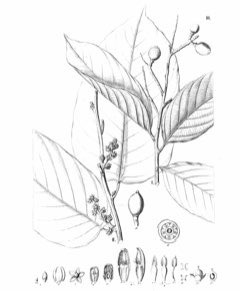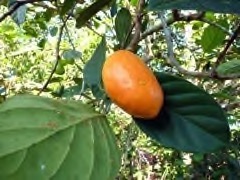 |
|
http://www.edibleplants.org |
 |
| caminoverde.org |
Translate this page:
Summary
Umari, Poraqueiba sericea, is an evergreen, tropical, and fairly fast-growing tree with no known medicinal uses. It can be found in South America particularly in northern Brazil, where it grows usually about 15-25 m tall with a dense pyramidal canopy. Its bole is straight and about 30-50 cm in diameter. Established plants are tolerant to drought but not to flooding. The fruits are edible specifically the fleshy pulp. It can be consumed raw or cooked. It yields oil which is edible as well. The wood is ideal for carpentry and construction but is mostly used for making charcoal. The plant can be grown from seeds and germination takes about 4-6 weeks after sowing.
Physical Characteristics

 Poraqueiba sericea is an evergreen Tree growing to 20 m (65ft) by 18 m (59ft) at a fast rate.
Poraqueiba sericea is an evergreen Tree growing to 20 m (65ft) by 18 m (59ft) at a fast rate.
See above for USDA hardiness. It is hardy to UK zone 10.
Suitable for: light (sandy), medium (loamy) and heavy (clay) soils, prefers well-drained soil and can grow in heavy clay and nutritionally poor soils. Suitable pH: mildly acid, neutral and basic (mildly alkaline) soils and can grow in saline soils.
It can grow in semi-shade (light woodland) or no shade. It prefers dry or moist soil and can tolerate drought.
UK Hardiness Map
US Hardiness Map
Synonyms
Poraqueiba acuminata Miers
Plant Habitats
Edible Uses
Edible Parts: Fruit Oil Seed
Edible Uses: Oil
Fruit - raw or cooked[416 ]. The fleshy pulp has a peculiar taste and aroma[416 ]. It is often served with manioc flour[3 ]416, and is made into a 'butter' for spreading on bread[355 ]. The fruit contains 12% oil and is rich in starch[317 ]. The yellowish fruit is around 7cm long and 5cm wide[416 ]. An edible oil is obtained from the fruit pulp and the seed[420 ].
References More on Edible Uses
Medicinal Uses
Plants For A Future can not take any responsibility for any adverse effects from the use of plants. Always seek advice from a professional before using a plant medicinally.
None known
References More on Medicinal Uses
The Bookshop: Edible Plant Books
Our Latest books on Perennial Plants For Food Forests and Permaculture Gardens in paperback or digital formats.

Edible Tropical Plants
Food Forest Plants for Hotter Conditions: 250+ Plants For Tropical Food Forests & Permaculture Gardens.
More

Edible Temperate Plants
Plants for Your Food Forest: 500 Plants for Temperate Food Forests & Permaculture Gardens.
More

More Books
PFAF have eight books available in paperback and digital formats. Browse the shop for more information.
Shop Now
Other Uses
Charcoal Fuel Oil Wood
Agroforestry Uses: The tree is often interplanted with crops such as Brazil nut, cashew, uvilla, and Inga species that grow well in poor, clay soils[355 ]. Other Uses Children cut the endosperm of the fruit into thin, opaque slices to make toy glasses[355 ]. The wood is medium to thick-textured, straight-grained, moderately heavy, hard, with moderate mechanical properties and not durable[420 ]. It is suitable for carpentry and internal use in construction[317 , 355 ]. It is popular for making charcoal[355 ].
Special Uses
Food Forest
References More on Other Uses
Cultivation details
Succeeds in a sunny position and in dappled shade[420 ]. Trees can grow well in very poor, heavy clay soils[355 ]. Intolerant of flooding[355 ]. Established plants are drought tolerant[420 ].
References Carbon Farming Information and Carbon Sequestration Information
Temperature Converter
Type a value in the Celsius field to convert the value to Fahrenheit:
Fahrenheit:
The PFAF Bookshop
Plants For A Future have a number of books available in paperback and digital form. Book titles include Edible Plants, Edible Perennials, Edible Trees,Edible Shrubs, Woodland Gardening, and Temperate Food Forest Plants. Our new book is Food Forest Plants For Hotter Conditions (Tropical and Sub-Tropical).
Shop Now
Plant Propagation
Seed - best sown as soon as it is ripe in a partially shaded position in individual containers. A medium germination rate can be expected, with the seed sprouting within 28 - 42 days[420 ]. Plants should be ready to plant out 7 - 8 months later[420 ].
Other Names
If available other names are mentioned here
Mari-preto, Umari-roxo, caniba, capibare, guacure, madi, mari, umarí, yumari, yuí.
Native Range
SOUTHERN AMERICA: South America (Amazon & Orinoco basins)
Weed Potential
Right plant wrong place. We are currently updating this section.
Please note that a plant may be invasive in one area but may not in your area so it's worth checking.
Conservation Status
IUCN Red List of Threatened Plants Status : This taxon has not yet been assessed

Growth: S = slow M = medium F = fast. Soil: L = light (sandy) M = medium H = heavy (clay). pH: A = acid N = neutral B = basic (alkaline). Shade: F = full shade S = semi-shade N = no shade. Moisture: D = dry M = Moist We = wet Wa = water.
Now available:
Food Forest Plants for Mediterranean Conditions
350+ Perennial Plants For Mediterranean and Drier Food Forests and Permaculture Gardens.
[Paperback and eBook]
This is the third in Plants For A Future's series of plant guides for food forests tailored to
specific climate zones. Following volumes on temperate and tropical ecosystems, this book focuses
on species suited to Mediterranean conditions—regions with hot, dry summers and cool, wet winters,
often facing the added challenge of climate change.
Read More
Expert comment
Author
Tul.
Botanical References
Links / References
For a list of references used on this page please go here
A special thanks to Ken Fern for some of the information used on this page.
Readers comment
| Add a comment |
|
If you have important information about this plant that may help other users please add a comment or link below. Only comments or links that are felt to be directly relevant to a plant will be included. If you think a comment/link or information contained on this page is inaccurate or misleading we would welcome your feedback at [email protected]. If you have questions about a plant please use the Forum on this website as we do not have the resources to answer questions ourselves.
* Please note: the comments by website users are not necessarily those held by PFAF and may give misleading or inaccurate information.
To leave a comment please Register or login here All comments need to be approved so will not appear immediately.
|
Subject : Poraqueiba sericea
|
|
|
|